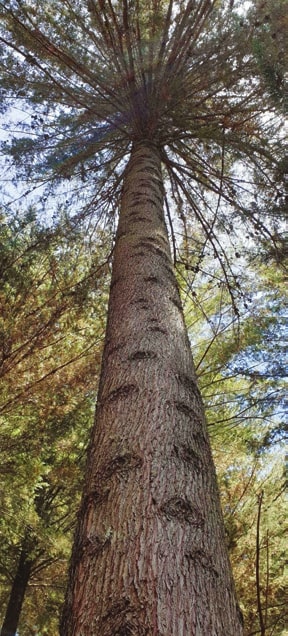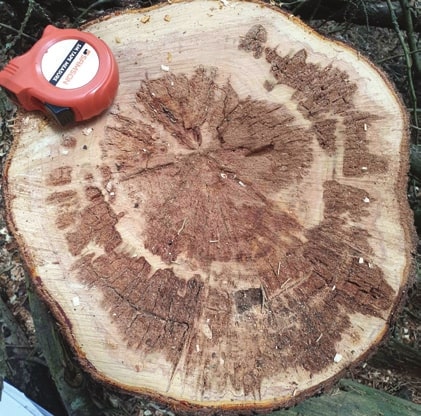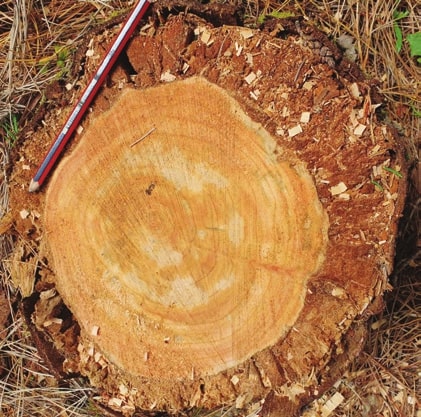Cypress trials at Don Tantrum’s property
Dean Satchell, New Zealand Tree Grower August 2020.
Don Tantrum planted and mapped several cypress trials on a range of sites on his farm near Taihape from 1990 to 2000, collecting promising material from around New Zealand. He planted this in his arboretum for later assessment with the intention of making selections which would improve the germplasm available to growers. This article summarises an assessment made this year of Don’s trials by myself and Angus Gordon and made possible with funding from the Neil Barr Farm Forestry Foundation.
There is a glossary at the end of this article of some of the words used which may be unfamiliar.
The most striking feature of Don’s collection is the irrefutable visual evidence of the promise which cypress has for growers. This is seen as growth, form and health, but what is also clear is that it is all about genetics. Don’s collection realises that promise and now it is time to hand this over to the next generation of growers.
Trees were assessed with seeds and cuttings collected from the most promising selections. Results from this research also include −
- Evidence that 20 years of age is an opportune time to make selections of cypress clones
- Confirmation that heartwood content is a main selection criterion for new clones because it is influenced by genetics.
The history
Cypress has been grown and harvested in New Zealand on farms for well over 100 years. Unfortunately, because disease-susceptible seed lines and clones have been planted extensively for the last three decades, the catastrophic failure of these has left the reputation of the species in tatters.
Most growers have become reluctant to again plant macrocarpa after experiencing complete crop failure. This is in contrast to the few who had good results from planting their own seed from good local trees. Canker-susceptible seed lines such as Strathallen and Longwoods, along with clones such as Kukupa and the Leylands, continue to plague growers because nurseries unwittingly propagate them and have not been offered alternatives.

New clonal selections
Clonal selection offers an opportunity for rapid deployment of improved cutting-grown cultivars. This is nothing new. However, the breakthrough for cypress breeding has been accepting that cypress should just be evaluated once they mature, at around 20 years old. Only at this age can selections be made based on low levels of fluting on the trunk, mature branch architecture, resilience to stem breakages and toppling, along with wood stiffness, heartwood colour and heartwood content.
The Cypress Development Group have responded with a plan to search for superior seedling-grown mature trees and cloning these. Some of these will grow well from cuttings regardless of maturation, the death knell for clonal propagation of other species such as radiata pine and larch. The Leyland cypress clones are an example where these have been propagated for over 100 years without maturation retarding growth rates, suggesting that unlike radiata pine, cypress does not suffer from physiological ageing.
What we are also beginning to observe is that a good cypress tree must have resilience to environmental challenges such as wind and disease, as well as having a fine-branched architecture and narrow-conical form. The other critical selection criterion is wood quality. Wood properties such as durability, stiffness, wood colour and heartwood content can all be tested for in mature trees.
The results
What we found in Don’s trials was that some clones and seed lines had consistently higher heartwood content regardless of site. Heartwood content narrows our initial selections, along with which clones propagate well. Then other wood properties can be tested for once these pass the test.


We took cutting material from 29 macrocarpa and lusitanica selections, which Patrick Milne of Southern Cypresses is propagating. From there, stool beds will be set up to provide material to nurseries. It will take a few years to increase production of our best selections for deployment at larger scale. We have started with Don Tantrum’s trials because these are well documented, carefully selected from around New Zealand and are at a good age for evaluating. The full report documenting our selections from Don’s collection can be found in the Cypress Development Group area of the NZFFA website.
Glossary for those new to cypress
Articles in Tree Grower are for people who grow trees but not everyone is at the same level of knowledge. For this article about cypress trials there were quite a few words which, for the beginner, would benefit from more explanation. The following mini-glossary is not comprehensive just a quick guide to a few of the words used.
Canker is a fungal disease in cypress, often fatal, with symptoms being dead foliage, lesions and deformation on the trunk.
Fluting is when the trunk of the tree has longitudinal furrows, often genetic, but also caused by canker.
Clones are exact replicas of the parent tree made by growing a cutting, unlike growing from seed.
Germplasm is a living genetic resource such as seeds or tissue maintained for the purpose of plant breeding, preservation and research.
Toppling is when the young tree falls over, usually following a storm and often due to poor planting technique, but often in the case of some cypress the root growth does not keep pace with the branches and foliage growth.
Maturation can be a problem if the same clones are used for many years and get physiologically old in the way the original tree ages, although for cypress this does not seem to be a problem.

 Farm Forestry New Zealand
Farm Forestry New Zealand